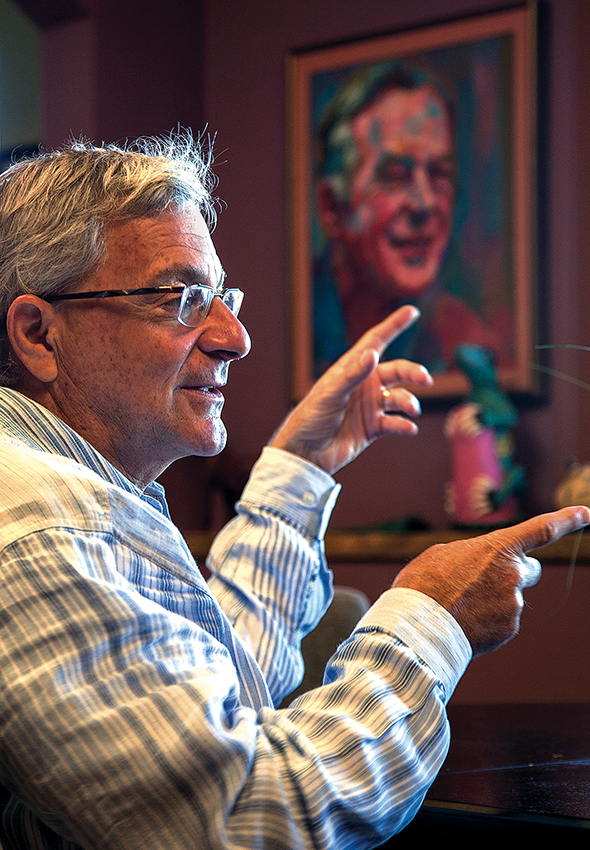Story by: Michaia Hernandez
Photo by: Lynn Levitt
Illustration by : Lauren Vellve
Dream tending is a new trend is psychoanalysis

It all started when he was about 12 years old.
Stephen Aizenstat was at Zuma Beach in Malibu when he wandered away from his family and found himself on the less populated area of the shore. Lost in his thoughts, he sat on top of a boulder and looked out at the sea.
“The tide was out there. There were tide pools and the rock was very animated and colorful,” he recounted. “I remember thinking, my goodness, this is like a dream.”
Then, an older teenage boy walked by and said, “You know, it’s as if rocks can talk.”
“I thought, oh my gosh, the heavens have spoken,” Aizenstat said. “That was an experience out of time for me because it wasn’t in my home in Granada Hills, and it wasn’t on the other side of the beach with all those big food stands and lifeguards. I’ll never forget it.”
This was the moment that sparked in Aizenstat the idea that dreams are alive, and we can interact with them.
He called this theory dream tending. It’s a method that revolves around the idea that all the elements in a dream—from people to the ocean—are alive, and they are as capable of dreaming as humans.
“It’s as if everything in the dream has a life of its own,” he explained. “It’s as if they’re interacting with one another along with us. The ‘who’ that’s dreaming the dream are probably all the figures in the dream.”
For instance, if one’s dreams include the element of the ocean, it could translate to the ocean using that dream to tell us something about itself, like if it is in trouble.
But this idea isn’t something that is supported by science, according to Julia Morgan Cohen, an adjunct professor who teaches physiological psychology at Pierce College.
Cohen said that dreaming isn’t only applicable to humans but that it doesn’t necessarily include everything around us.
“This is what we can say mammals and birds seem to have, REM sleep. What they’re thinking, we don’t know because they can’t tell us. But we can see that they’re acting just as we act when we’re dreaming,” Cohen said.
As a boy, Aizenstat learned to be passionate about dreams and his imagination. He noticed that as time went by and the ages of the people around him began to rise steadily, dreaming was ignored.
“As I got older, most people stopped dreaming. People don’t talk about dreams that much, because our dreams are imagined to be something that are not real,” he said. “Once upon a time, people would wake up and talk about their dreams; they would share stories, but today’s world is so quick and so fast, there’s hardly any time to sit and tell stories or talk about dreams.”
Dream tending, which was developed from preexisting theories about the psyche, has its roots with indigenous people.
“They would listen to dreams and imagine that they were as real in the imaginal world as we are in this world,” Aizenstat explained. “They really took the imagination much more seriously than we do.”
Dream tending emphasizes relationship over interpretation. Instead of elucidating dreams for an explanation, tenders get to know the figures in dreams by letting them do the talking.
“You get to know them as much as they know us,” he emphasized. “If we tend to images instead of quickly interpreting them into a system, they will open themselves into a different awareness.”
Through workshops and lectures, Aizenstat has passed on the practice of dream tending to others, including Sally Carless, a photographer from Ojai.
“Once I saw him work I was just so impacted by the depth of the work, and I wanted to know more about it,” she said.
Even though Carless had no problem understanding and applying Aizenstat’s teachings to her life, Carless was at first hesitant when it came to professionally tending to other people’s dreams.
“I didn’t start doing it professionally for a long time after training because there’s just so much to it. I was cautious about doing it with other people because you can go really deep with it,” said Carless, who has been a tender for more than over 15 years.
“It’s hard to describe the power of it until you’ve seen it. You get a much deeper level of information about what’s going on in your life. The dreams help you open up to another level that people don’t access otherwise. It’s like opening up the doors and windows and seeing a much bigger picture than what you were able to see before.”
Though dream tending isn’t responsible for all the life changes Carless has gone through—she moved to Ojai to be closer to nature and has opened a homeschooling-based entity—she credits it for being the key change in her life.
“For me, it’s been a valuable tool, a kind of life trajectory that pointed me to this direction,” she said.
Carless learned from Aizenstat the core principle of dream tending—that all things in the universe are connected.
“All dreams come forward and they offer something to us,” Aizenstat said. “It’s a question of learning how to listen in and taking the time.”



